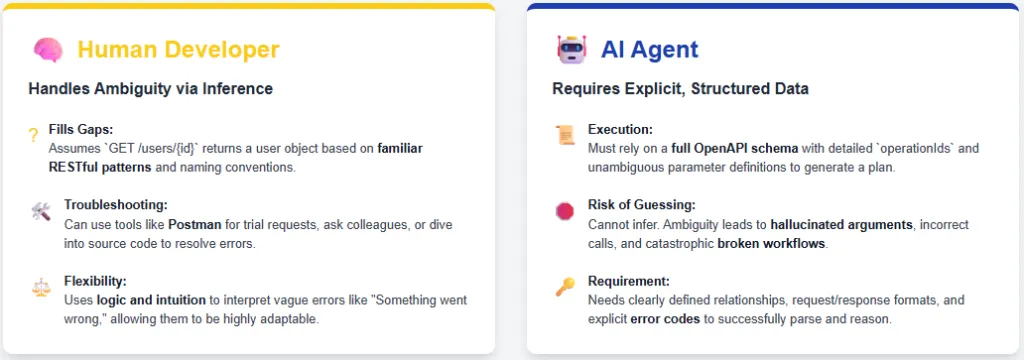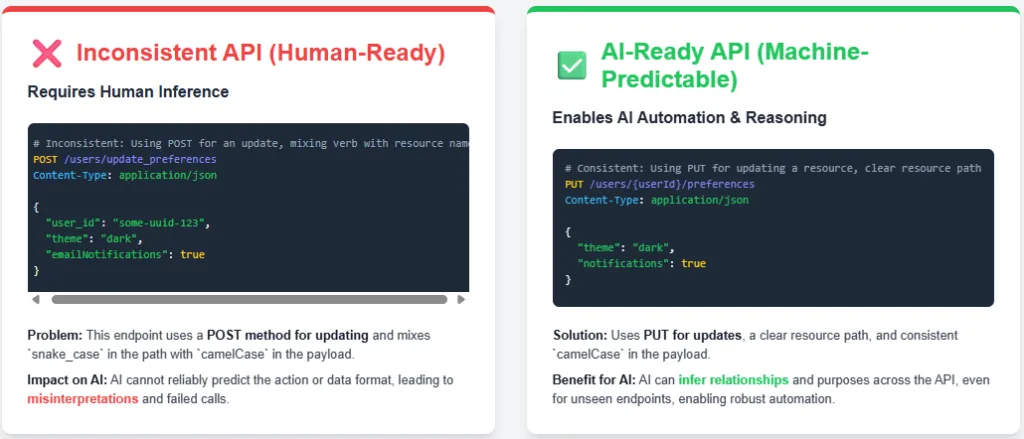How to create an AI-ready API?
Postman recently published a comprehensive checklist and developer guide for building AI-ready APIs, highlighting a simple fact: even the most powerful AI models are only as good as the data they receive, and that data comes from your API. If your endpoints are inconsistent, unclear, or unreliable, the model will waste time fixing bad inputs instead of generating insights. Postman’s playbook distills years of best practices into practical steps to help teams make their APIs predictable, machine-readable, and reliable for AI workloads.
This article summarizes the key ideas of the manual. As we move into a world where agents (rather than humans) make purchases, compare options, and interact with services, APIs must continue to evolve. Unlike developers, agents cannot compensate for confusing documentation or ambiguous behavior. They rely on standardized schemas and automatically generated, machine-readable documentation that stays in sync with your architecture. The goal is simple: create APIs that humans and AI agents can instantly understand so that your system can scale smarter and unlock its full potential.
Machine consumable metadata
Humans can infer missing details from vague API documentation, but AI agents cannot—they rely entirely on explicit, machine-readable metadata. Instead of saying “This endpoint returns user preferences“An AI-ready API must define everything: request type, parameter schema, response structure, and object definition. Clear metadata like the example above removes ambiguity, ensures agents don’t guess, and enables the API to be fully understood by machines.



Rich error semantics
Developers can explain ambiguous errors such as “something went wrong,” but AI agents can’t—they need precise, structured guidance. AI-ready APIs must clearly state what failed, why it failed, and how to fix it. Rich error metadata, including things like code, information, expectedand Received Eliminate guesswork and enable agents to self-correct rather than get bogged down.


introspection ability
In order for APIs to be AI-ready, they must move beyond human-centric, vague documentation. Unlike developers who can use context and RESTful conventions to infer missing details, AI agents rely entirely on structured data for planning and execution. This means that the API must provide complete introspection through a complete schema, explicitly defining all endpoints, parameters, data schemas, and error codes. Without this clarity, AI systems are forced to guess, which inevitably leads to workflow disruptions and unreliable phantom behavior.


Consistent naming pattern
AI systems rely on consistent patterns, so predictable naming conventions make your API easier for them to understand and navigate. When endpoints and fields follow a clear, uniform structure (such as correct REST methods and consistent casing), AI can infer relationships and behaviors without guesswork. This reduces ambiguity and enables more accurate automation, reasoning, and integration throughout the API.


predictable behavior
AI agents require strict consistency—the same input should always produce the same structure, format, and fields. Humans can use intuition to resolve inconsistent responses, but AI cannot hypothesize or investigate; it only learns from the patterns you provide. If naming, nesting, or errors differ between endpoints, the agent will become unreliable or crash entirely. To be AI ready, your API must enforce predictable responses, consistent naming, consistent error handling, and zero hidden edge cases. In short: inconsistent input leads to inconsistent agent behavior.


proper documentation
When documentation is unclear, humans can look things up, but AI agents can’t—they only know what your API explicitly tells them. Without clear, complete documentation, agents cannot discover endpoints, understand parameters, predict responses, or recover from errors. For an AI-ready API, good documentation isn’t optional—it’s the only way the agent can learn and reliably interact with your system.
Reliable and fast
AI agents act as coordinators, making fast and often parallel API calls, so the speed and reliability of the API directly affects its performance. Humans can wait for slow responses or retry manually, but agents can time out, fail, or disrupt the entire workflow. In a fast, automated environment, an AI system is only as powerful as the APIs it relies on. If your API can’t keep up, neither can your AI.
discoverability
Humans can track down missing APIs through wikis, chat, code, or intuition, but AI agents cannot. If an API doesn’t explicitly publish structured, searchable metadata, then it simply doesn’t exist for them. AI systems rely on standardized, discoverable specifications and examples to understand how to use APIs. Making your API visible, accessible, and well-indexed through a platform like the Postman API Network ensures that developers and agents can reliably find and integrate it.

I am a Civil Engineering graduate (2022) from Jamia Millia Islamia, New Delhi and I am very interested in data science, especially neural networks and their applications in various fields.
🙌 FOLLOW MARKTECHPOST: Add us as your go-to source on Google.


